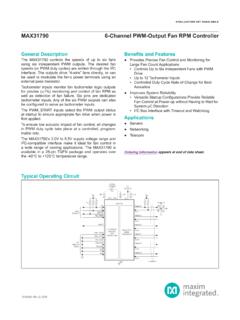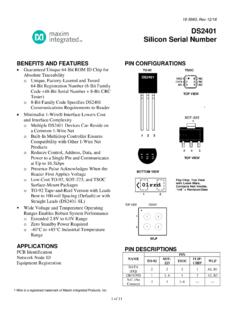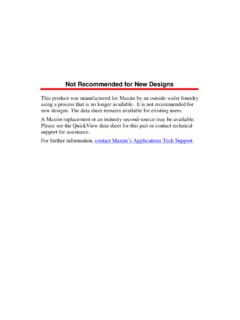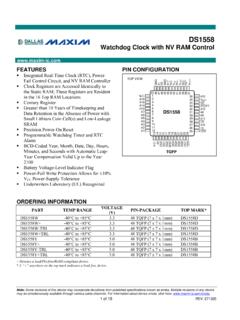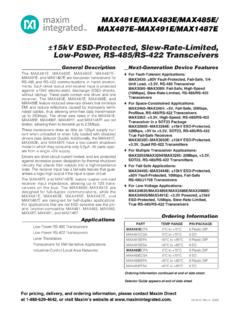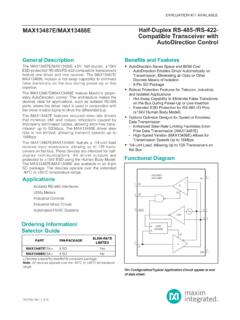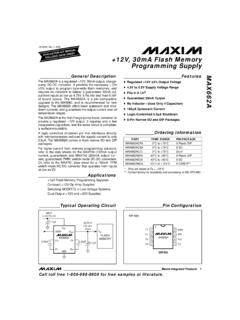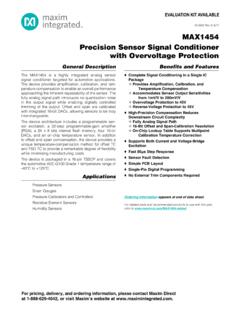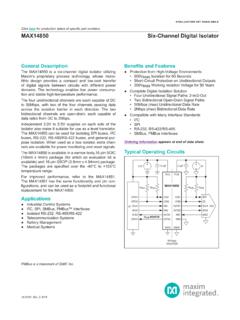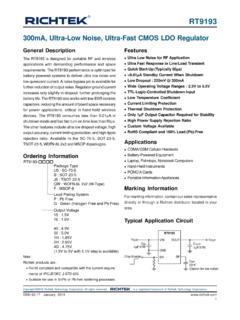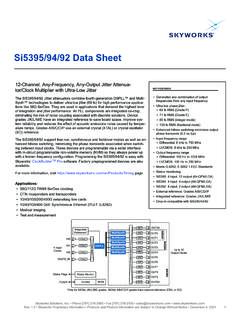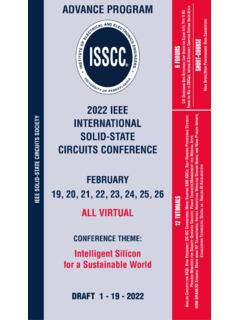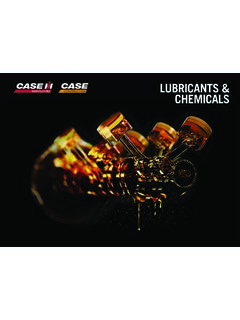Transcription of Click here for production status of specific part numbers ...
1 General DescriptionThe MAX77650/MAX77651 provide highly-integrated bat-tery charging and power supply solutions for low-power wearable applications where size and efficiency are critical. Both devices feature a SIMO buck-boost regulator that provides three independently programmable power rails from a single inductor to minimize total solution size. A 150mA LDO provides ripple rejection for audio and other noise -sensitive applications. A highly configu-rable linear charger supports a wide range of Li+ battery capacities and includes battery temperature monitoring for additional safety (JEITA).The devices include other features such as current sinks for driving LED indicators and an analog multiplexer that switches several internal voltage and current signals to an external node for monitoring with an external ADC. A bidi-rectional I2C interface allows for configuring and check-ing the status of the devices.
2 An internal on/off controller provides a controlled startup sequence for the regulators and provides supervisory functionality when the devices are on. Numerous factory programmable options allow the device to be tailored for many applications, enabling faster time to and Features Highly Integrated Smart Power Selector Li+/Li-Poly Charger 3 Output, Single-Inductor Multiple-Output (SIMO) Buck-Boost Regulator 150mA LDO 3-Channel Current Sink Driver Analog MUX Output for Power Monitoring Low Power A Shutdown Current A Operating Current (3 SIMO Channels + LDO) Charger Optimized for Small Battery Size Programmable Fast-Charge Current from to 300mA Programmable Battery Regulation Voltage from to Programmable Termination Current from to 45mA JEITA Battery Temperature Monitors Adjust Charge Current and Battery Regulation Voltage for Safe Charging Flexible and Configurable I2C Compatible Interface and GPIO Factory OTP Options Available Small Size x x WLP Package 30-Bump, WLP, 6x5 Array Small Total Solution Size ( )Applications Bluetooth Headphones/Hearables Fitness, Health, and Activity Monitors Portable Devices Internet of Things (IoT)Ordering Information appears at end of data ; Rev 7.
3 9/18 Smart Power Selector is a trademark of Maxim Integrated Products, Application INPUTMAX77650 PWR_HLDnRSTSDASCLnIRQSYSTEM RESOURCESIN_SBBGPIO**AMUXAMUXBATT+THMTBI AS**PULLUP RESISTORS NOT DRAWNBSTMAX77650/MAX77651 ultra -Low Power PMIC with 3-Output SIMO and Power Path Charger for Small Li+EVALUATION KIT AVAILABLEC lick here for production status of specific part and Features ..1 Applications ..1 Simplified System Diagram ..1 Absolute Maximum Information ..7 Electrical Characteristics Top Level ..9 Electrical Characteristics Global Characteristics Smart Power Selector Charger ..12 Electrical Characteristics Adjustable Thermistor Temperature Monitors ..16 Electrical Characteristics Analog Multiplexer and Power Monitor Characteristics SIMO Characteristics LDO ..19 Electrical Characteristics Current Sinks ..21 Electrical Characteristics I2C Serial Operating Characteristics.
4 25 Pin Configuration ..34 Pin Materials ..36 Top-Level Interconnect Simplified Diagram ..36 Global and POR Undervoltage Lockout Comparator ..38 SYS Overvoltage Lockout Comparator ..38nEN Enable Input ..38nEN Manual Dual-functionality: Push-Button vs. Slide-Switch ..39 Interrupts (nIRQ)..39 Reset Output (nRST) ..39 Power Hold Input (PWR_HLD)..39 General-Purpose Input Output (GPIO)..40On/Off Power Inputs (nEN, GPI, CHGIN) ..49 Smart Power Selector Charger ..50 TABLE OF Integrated 2 MAX77650/MAX77651 ultra -Low Power PMIC with 3-Output SIMO and Power Path Charger for Small Li+Features ..50 Charger Symbol Reference Guide ..51 Smart Power Current Input Voltage System Voltage Temperature State Off States ..54 Top-Off Timer Fault State ..54 Fast-Charge Timer Fault State ..55 Battery Temperature Fault State ..55 JEITA-Modified Charge Profile.
5 55 Charger Applications a Valid System Voltage ..56 CHGIN/SYS/BATT Capacitor Thermistor Temperature Monitors ..57 Thermistor Temperature Applications Different Thermistor ..60 NTC Thermistor Multiplexer & Power Monitor AFEs ..61 Measuring Battery Current ..62 Method for Measuring Discharging Current ..62 Method for Measuring Charging Benefits and Features ..63 SIMO Control Scheme ..64 SIMO Soft-Start ..64 SIMO Active Discharge Resistance ..64 SIMO Applications Available Output OF CONTENTS (CONTINUED) Integrated 3 MAX77650/MAX77651 ultra -Low Power PMIC with 3-Output SIMO and Power Path Charger for Small Li+TABLE OF CONTENTS (CONTINUED)Inductor Selection ..65 Input Capacitor Capacitor Capacitor Selection ..66 SIMO Switching ..67 Features ..67 LDO Simplified Block Active Discharge Resistor ..67 LDO Soft-Start ..68 LDO Applications and Output Capacitor Selection.
6 68 Current Sinks ..71 Current Sink Applications Information ..71 LED Assignment ..71 Unused Current Sink Ports ..71I2C Serial Interface ..72I2C System Interface Data Transfer ..72I2C Start and Stop Conditions ..72I2C Acknowledge Slave Clock General Call Device ID ..74I2C Communication Communication to a Single Multiple Bytes to Sequential Registers ..76 Reading from a Single from Sequential HS-mode for operation up to Application Circuit ..79 Ordering Information ..80 Revision Integrated 4 MAX77650/MAX77651 ultra -Low Power PMIC with 3-Output SIMO and Power Path Charger for Small Li+LIST OF FIGURESF igure 1. Top-Level Interconnect Simplified Diagram ..37 Figure 2. nEN Usage Timing 3. GPIO Block Diagram ..41 Figure 4. Top-Level On/Off 5. Power-Up/Power-Down 6. Flexible Power Sequencer Basic Timing 7. Startup Timing Diagram Due to nEN.
7 47 Figure 8. Startup Timing Diagram Due to Charge Source 9. Debounced 10. Linear Charger Simplified Block Diagram ..50 Figure 11. Charger Simplified Control 12. Charger State 13. Example Battery Charge 14. Thermistor Logic Functional 15. Safe-Charging Profile Example ..58 Figure 16. Thermistor Bias State 17. Thermistor Circuit with Adjusting Series and Parallel 18. SIMO Detailed Block Diagram ..63 Figure 19. LDO Capacitance for Stability ..69 Figure 20. LDO Simplified Block 21. Current Sink Block 22. I2C Simplified Block 23. I2C System 24. I2 C Start and Stop Conditions ..72 Figure 25. Acknowledge 26. Slave Address Example ..73 Figure 27. Writing to a Single Register with the Write Byte 28. Writing to Sequential registers X to N ..76 Figure 29. Reading from a Single Register with the Read Byte Protocol ..77 Figure 30. Reading Continuously from Sequential Registers X to 31.
8 Engaging HS Integrated 5 MAX77650/MAX77651 ultra -Low Power PMIC with 3-Output SIMO and Power Path Charger for Small Li+LIST OF TABLEST able 1. Regulator Summary ..36 Table 2. On/Off Controller Transition/State ..44 Table 3. Charger Quick Symbol Reference 4. Trip Temperatures vs. Trip Voltages for Different NTC ..59 Table 5. Example RS and RP Correcting Values for NTC Above 3380K ..60 Table 6. NTC Thermistors ..60 Table 7. AMUX Signal Transfer 8. Battery Current Direction Decode ..62 Table 9. SIMO Available Output Current for Common Applications ..65 Table 10. Example Inductors ..65 Table 11. I2C Slave Address Integrated 6 MAX77650/MAX77651 ultra -Low Power PMIC with 3-Output SIMO and Power Path Charger for Small Li+nEN, PWR_HLD, nIRQ, nRST to GND .. to VSYS + , SDA, GPIO to GND .. to VIO + to GND .. to + , BATT to GND .. to + to IN_SBB .. to + to GND.
9 To + , THM, TBIAS to GND .. to + , nRST, SDA, AMUX, GPIO Continous Current .. 20mACHGIN Continuous Continuous Current .. Continuous Current (Note 1) .. to GND (Note 2) .. to VIN_LDO + , VIO to GND .. to the lower of (VSYS + ) and + , LED1, LED2 to LGND .. to + to PGND .. to + Continuous Current (Note 3) .. Continuous Current (Note 4) .. , SBB1, SBB2 to PGND (Note 2) .. to + to IN_SBB .. to + to LXB .. to + , SBB1, SBB2 Short-Circuit Duration ..ContinuousPGND to GND .. to + to GND .. to + Temperature Range ..-40 C to +85 CJunction Temperature ..+150 CStorage Temperature Range ..-65 C to +150 CSoldering Temperature (reflow) ..+260 CContinuous Power Dissipation (Multilayer Board) (TA = +70 C, derate C above +70 C) ..1632mWPACKAGE CHARACTERISTICSVALUESP ackage CodeW302H2+1 Outline Number21-100047 Land Pattern NumberRefer to Application Note 1891 Thermal Resistance, Four-Layer Board:Junction-to-Ambient ( JA)49 C/W (2s2p board)Absolute Maximum RatingsStresses beyond those listed under Absolute Maximum Ratings may cause permanent damage to the device.
10 These are stress ratings only, and functional operation of the device at these or any other conditions beyond those indicated in the operational sections of the specifications is not implied. Exposure to absolute maximum rating conditions for extended periods may affect device thermal resistances were obtained using the method described in JEDEC specification JESD51-7, using a four-layer board. For detailed information on package thermal considerations, refer to the latest package outline information and land patterns (footprints), go to Note that a + , # , or - in the package code indicates RoHS status only. Package drawings may show a different suffix character, but the drawing pertains to the package regardless of RoHS InformationNote 1: Do not repeatedly hot-plug a source to the BATT terminal at a rate greater than 10Hz. Hot plugging low-impedance sources results in an ~8A momentary (~2 s) current 2: When the active discharge resistor is engaged, limit its power dissipation to an average of 3: LXA has internal clamping diodes to PGND and IN_SBB.

